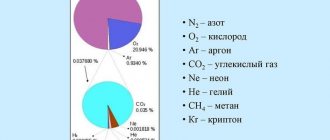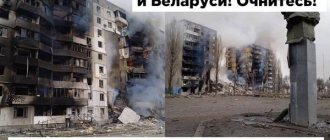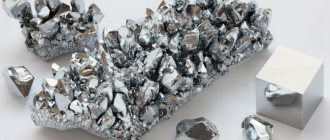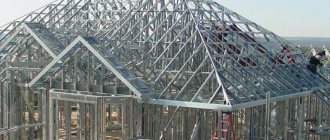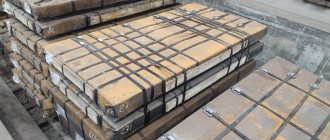Some gases are called inert and do not react to other chemicals. It is impossible to synthesize any chemical compound from them. However, such gases are used in industry, where their physical properties are relevant. One of the inert gases is argon. In this article we will talk about the characteristics of argon gas, areas of application. Let us explain what it is - argon gas in chemistry and physics. We will tell you what pressure is maintained in the argon cylinder. This information will help you better understand for what purposes, how and with what restrictions you can use this technical gas in your enterprise or at home.
Methods for producing argon
A significant amount of gas is contained in the air. Therefore, it is isolated from the air mass using low-temperature distillation units. This process occurs in several stages:
- The air is cleaned of dust particles and compressed to produce liquid.
- In liquid form, air is rectified from nitrogen, oxygen, and argon.
- Having separated the nitrogen, the mixture of oxygen and argon is purified using electrolytic hydrogen.
In a rectification plant, inert gas boils at −185.3˚C, oxygen three degrees higher, nitrogen thirteen degrees lower.
Argon is also produced in manufacturing processes as a by-product. It is extracted by producing ammonia. In this case, Ar is mixed with nitrogen and is of no value; it costs much less than cryogenic argon.
History of discovery
The background to the discovery of Ar began in 1785. An outstanding scientist and naturalist from Great Britain, Henry Cavendish, studied the composition of air. He subjected nitrogen to oxidation and weighed the resulting oxides. At the end of the experiment, gas remained in the vessel. Cavendish determined its volume to be 0.8% of the initial volume of air.
The scientist was unable to determine the composition of this gas. A century later, Sirs John Rayleigh and William Ramsay returned to the problem. During their experiments, they discovered that nitrogen released from the air has a higher density than nitrogen obtained during the decomposition reaction of ammonium nitrite.
in 1884 they managed to isolate a certain gas from the air that was denser than nitrogen. This substance had a monatomic molecular structure and was extremely inert - i.e. did not react with other substances.
At a meeting of the Royal Society, the new gas was given the name “argon”, which translated from ancient Greek meant “calm, lazy”
Types of argon
Argon isotopes with atomic masses from 29 to 54 have been discovered. There are 3 types of Ar isotopes in the air:
- 40 (prevalence rate 99.600%);
- 36 (prevalence rate 0.337%);
- 38 (prevalence rate 0.063%).
There are three aggregate states:
- liquid - stored in special containers and subsequently gasified;
- gas;
- solid.
Physical and chemical properties
The properties of argon are typical of a member of group VIII.
At ordinary temperatures, Ar is in a gaseous state. The molecule includes a single atom, the chemical formula is very simple: Ar. The boiling point is very low: -185.8 °C at atmospheric pressure.
Solubility in water is low - only 3.29 ml per 100 ml of liquid
The density of argon under normal conditions is 1.78 kg/m3. The molar heat capacity of the gas is 20.7 J/Kmol.
Characteristics of argon and other inert gases
The gas is almost completely inert. To date, scientists have managed to obtain only two of its compounds - CU(Ar)O and argon hydrofluoride. The compounds exist only at ultra-low temperatures. It is assumed that Ar may be part of excimer-type molecules that are unstable in the normal state. Such molecules can only exist in an excited state, for example, during a high-intensity electrical discharge. Such compounds are possible with mercury, oxygen and fluorine.
Electronegativity on the Pauling scale is 4.3.
Both the oxidation state and the electrode potential have a zero value, which is typical for an inert gas.
The ionic radius is 154, the covalence radius is 106 PM. Ionization threshold - 1519 kJ/mol
Atomic and molecular mass
Such important parameters as atomic and molecular masses show how much the mass of a molecule of a substance and the mass of its atom, respectively, exceed a value equal to one twelfth of the mass of a hydrogen atom.
Due to the fact that the Ar molecule consists of a single atom, the molecular and atomic mass of argon are identical and amount to 39.984.
Argon structure and properties
Isotopes
Under natural conditions, Ar occurs as three stable isotopes
- 36Ar – the percentage of this isotope is 0.337% in the nucleus of 18 protons and 18 neutrons;
- 38Ar - its share is only 0.063%, there are 18 protons and 20 neutrons in the nucleus;
- 40Ar is the most common, its share is 99.6%, the nucleus also has 18 protons, but already 22 neutrons.
It was possible to artificially obtain isotopes with a mass index from 32 to 55, the most stable of which was 39Ar, whose half-life is 268 years.
The large percentage of 40Ar among the isotopes found in nature is caused by its constant formation during the decay reaction of the potassium-40 isotope. Per 1000 kg of potassium during such reactions no more than 3100 40Ar atoms are formed per year. But, since these reactions take place continuously over hundreds of millions of years, the isotope has accumulated in nature in significant volumes.
The dominance of the heavy isotope in nature determines the fact that the atomic weight of Ar exceeds the atomic weight of potassium, which is located next to it in the table. When the Periodic Table was created, there was no such contradiction, since argon was discovered and its properties were studied much later, in the first decade of the 20th century. Ar was initially placed in the first group of the table; the eighth group was allocated later.
Ions
Like other noble gases (such as He and Ne), Ar is susceptible to ionization. When atoms are excited and given high energies, molecular Ar2+ ions appear.
Molecule and atom
For inert gases, these concepts are identical, since these elements do not want to enter into a chemical bond even with their own kind. The molecule includes one atom, the chemical formula of the gas does not differ from the designation of the element: Ar.
Molar mass
The molar mass of argon is 39.95 g/mol.
There are several methods for calculating it:
- Using the relative atomic mass M and the proportionality coefficient k, expressing the relationship between the relative mass and the molar mass. This coefficient is a universal constant and is equal for all elements. Molar mass M is expressed as the product of the proportionality coefficient and the relative mass.
- Using molar volume. You will need to find the volume occupied by a certain mass of gas under normal conditions, then calculate the mass of 22.4 liters of the substance under the same conditions.
- Using the Mendeleev-Clapeyron equation simulating an ideal gas.
pV = mRT / M,
Having carried out the transformations, we obtain the expression for the molar mass:
M=mRT/pV
Where
- p – pressure in pascals,
- V – volume in cubic meters
- m – mass in grams,
- T - temperature in Kelvin,
- R is a constant whose value is 8.314 J/(mol×K).
Application of argon
Where is argon used? There are many areas of its application in industry. For example, in chemical reactions to displace oxygen from a substance. The operation of argon is cheaper compared to other inert gases. It forms a protective environment when welding hardware, displaces water and oxygen in food storage tanks.
Argon is used to fill the bulbs of lighting fixtures—incandescent lamps. With it, devices shine longer and brighter. Argon is also used in the manufacture of fluorescent lamps. It makes the electric arc easier to ignite and the electrodes last longer.
Argon is used to fill double-glazed windows for windows to increase their sound and heat insulation. The gas is transparent and allows window companies to produce multi-layer glass units with argon without compromising their transparency.
Inert gas is also used for plasma cutting of metal products. With it, an arc occurs at low voltage; structurally simple devices can be used. When plasma is generated using argon, a minimum of harmful volatile compounds are obtained during metal processing. This is why argon is the best companion for hand-held devices.
Argon is also used in medicine. It is used to perform argon coagulation, remove tumors, and stop bleeding.
In the chemical industry, ultrapure substances are produced and analyzed using argon. In metallurgy, Ar is used to mix molten substances and process tantalum, titanium, zirconium, beryllium and other metals. The inert gas helps reduce chromium oxidation when producing chromium coated steel.
Recommended reading:
- How much argon is used when welding?
- What types of technical argon are there and what are they used for?
General characteristics of Ar
Ar belongs to the group of inert gases. The charge of its nucleus is 18; the element is located under the same number in the periodic table.
Of all the members of group VIIIA, it is the most commonly found in nature. The volume fraction of Ar in the atmosphere is 0.93%, the mass fraction is 1.28%. The element is a colorless, tasteless and odorless gas. Chemically inactive - argon does not react and practically does not combine with any elements or substances, with the exception of CU(Ar)O and argon hydrofluoride.
Very poorly soluble in water, slightly greater solubility is observed when interacting with organic solvents.
Use of argon in welding
When welding metals, argon is used to maintain a protective environment. When working with ferrous metals, argon is mixed with oxygen, carbon dioxide, helium, and hydrogen.
Since inert gas is heavier than air, it protects metal products more effectively during welding operations. Spreading over the surface of the hardware, argon long and reliably protects a large area of molten and heated metal. In welding work, the use of argon produces a flawless seam and increases productivity. The seam melts well with one pass. With Ar, cheaper welding wires can be used.
When welding aluminum sheets, argon is mixed with helium for optimal processing temperature. When TIG welding, the gas protects the weld pool and the electrode tip.
Isotopes:
Three isotopes of argon exist in nature. These isotopes are argon-36, argon-38 and argon-40. Isotopes form two or more elements. Isotopes differ from each other depending on their mass number. The mass number is written to the right of the element's name - this is the mass number. The mass number is represented by the number of protons plus neutrons in the nucleus of an element's atom. The number of protons defines an element, but the number of neutrons in an atom of any one element can vary. Each change is an isotopic element.
A radioactive isotope is one that decays and emits some form of radiation. Radioactive isotopes are formed when small particles shoot at atoms. These particles get stuck in the atoms and make them a radioactive element.
No radioactive isotopes of argon have any practical use. However, a single non-radioactive isotope can be used to determine the age of very old rocks. This method of dating and determining the age of rocks is described in the potassium record.
Interesting Facts
There are a lot of interesting facts related to argon. It’s worth starting with the fact that argon has been banned for use by the international anti-doping company since 2014. The lack of oxygen from inhalation likely activates the body's own erythropoietin (EPO). It is also worth noting that argon at a pressure of about 24 bar can have an analgesic effect. An interesting point is that argon reserves in the atmosphere are replenished on Earth due to solar rays, and in the earth's crust due to underground nuclear explosions.
Safety requirements
Argon is non-toxic and non-explosive, but it is dangerous to life: if it is inhaled, a person instantly loses consciousness from suffocation, and death can occur within a few minutes. To ensure the safety of workers, equipment and facilities must be sealed, and production premises must be provided with ventilation. Argon gas is heavier than air and can accumulate in poorly ventilated areas near the floor and in pits, as well as in the internal volumes of equipment intended for the production, storage and transportation of gaseous and liquid argon. At the same time, the oxygen content in the air decreases, which leads to oxygen deficiency, and with a significant decrease in oxygen content - to suffocation, loss of consciousness and death of a person. In places where argon gas may accumulate, it is necessary to control the oxygen content in the air (the volume fraction of oxygen in the air must be at least 19%). Liquid argon is a low-boiling liquid that can cause frostbite to the skin and damage to the mucous membrane of the eyes. When sampling and analyzing liquid argon, it is necessary to wear safety glasses.
